HRM 4 Coursework: Report on Monsanto Company Human Resource Management
VerifiedAdded on 2022/10/19
|6
|1014
|67
Report
AI Summary
This report provides an in-depth analysis of the Monsanto Company's human resource management practices. It begins with an overview of the company's history, mission statement (now under Bayer), and strategic goals, including its focus on water conservation and nutrient-rich food production. The report then delves into a SWOT analysis, highlighting Monsanto's strengths, weaknesses, opportunities, and threats. A key section examines the company's diversity plan, including its ranking in DiversityInc's list and its approach to human rights management through global risk assessments. The report also covers the company's approach to mentoring, training, and talent retention. The report is supported by references to academic sources.
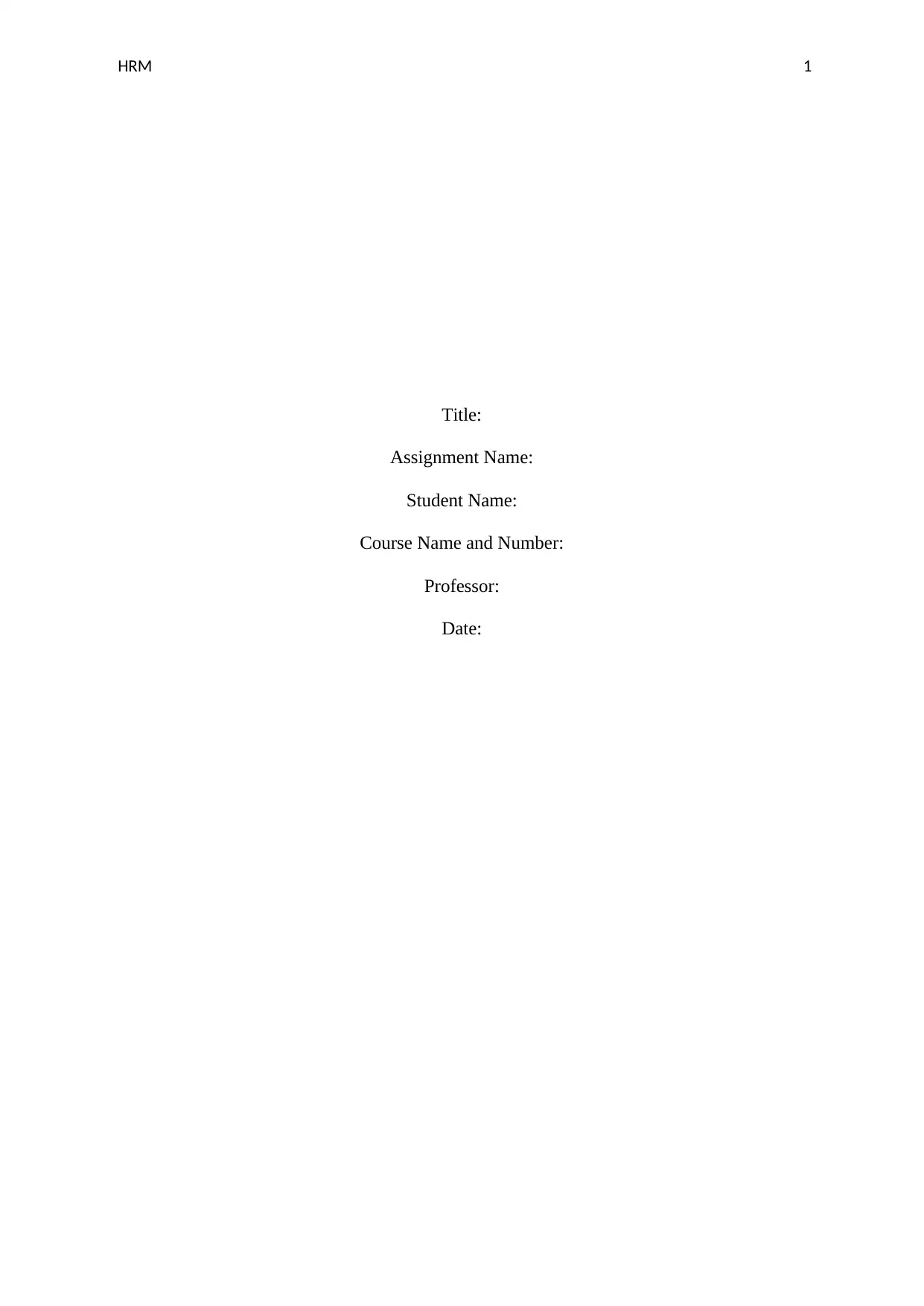
HRM 1
Title:
Assignment Name:
Student Name:
Course Name and Number:
Professor:
Date:
Title:
Assignment Name:
Student Name:
Course Name and Number:
Professor:
Date:
Paraphrase This Document
Need a fresh take? Get an instant paraphrase of this document with our AI Paraphraser
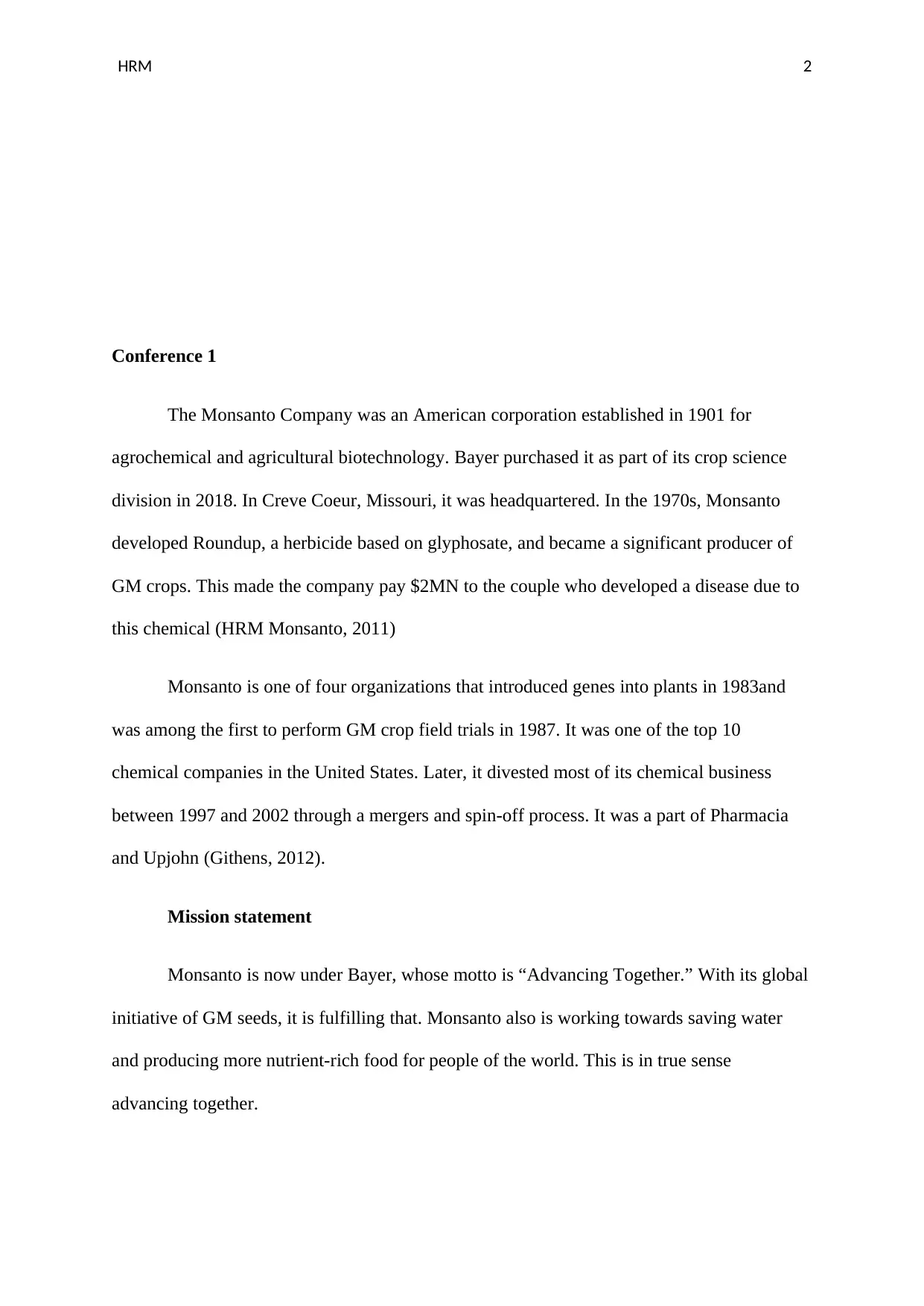
HRM 2
Conference 1
The Monsanto Company was an American corporation established in 1901 for
agrochemical and agricultural biotechnology. Bayer purchased it as part of its crop science
division in 2018. In Creve Coeur, Missouri, it was headquartered. In the 1970s, Monsanto
developed Roundup, a herbicide based on glyphosate, and became a significant producer of
GM crops. This made the company pay $2MN to the couple who developed a disease due to
this chemical (HRM Monsanto, 2011)
Monsanto is one of four organizations that introduced genes into plants in 1983and
was among the first to perform GM crop field trials in 1987. It was one of the top 10
chemical companies in the United States. Later, it divested most of its chemical business
between 1997 and 2002 through a mergers and spin-off process. It was a part of Pharmacia
and Upjohn (Githens, 2012).
Mission statement
Monsanto is now under Bayer, whose motto is “Advancing Together.” With its global
initiative of GM seeds, it is fulfilling that. Monsanto also is working towards saving water
and producing more nutrient-rich food for people of the world. This is in true sense
advancing together.
Conference 1
The Monsanto Company was an American corporation established in 1901 for
agrochemical and agricultural biotechnology. Bayer purchased it as part of its crop science
division in 2018. In Creve Coeur, Missouri, it was headquartered. In the 1970s, Monsanto
developed Roundup, a herbicide based on glyphosate, and became a significant producer of
GM crops. This made the company pay $2MN to the couple who developed a disease due to
this chemical (HRM Monsanto, 2011)
Monsanto is one of four organizations that introduced genes into plants in 1983and
was among the first to perform GM crop field trials in 1987. It was one of the top 10
chemical companies in the United States. Later, it divested most of its chemical business
between 1997 and 2002 through a mergers and spin-off process. It was a part of Pharmacia
and Upjohn (Githens, 2012).
Mission statement
Monsanto is now under Bayer, whose motto is “Advancing Together.” With its global
initiative of GM seeds, it is fulfilling that. Monsanto also is working towards saving water
and producing more nutrient-rich food for people of the world. This is in true sense
advancing together.
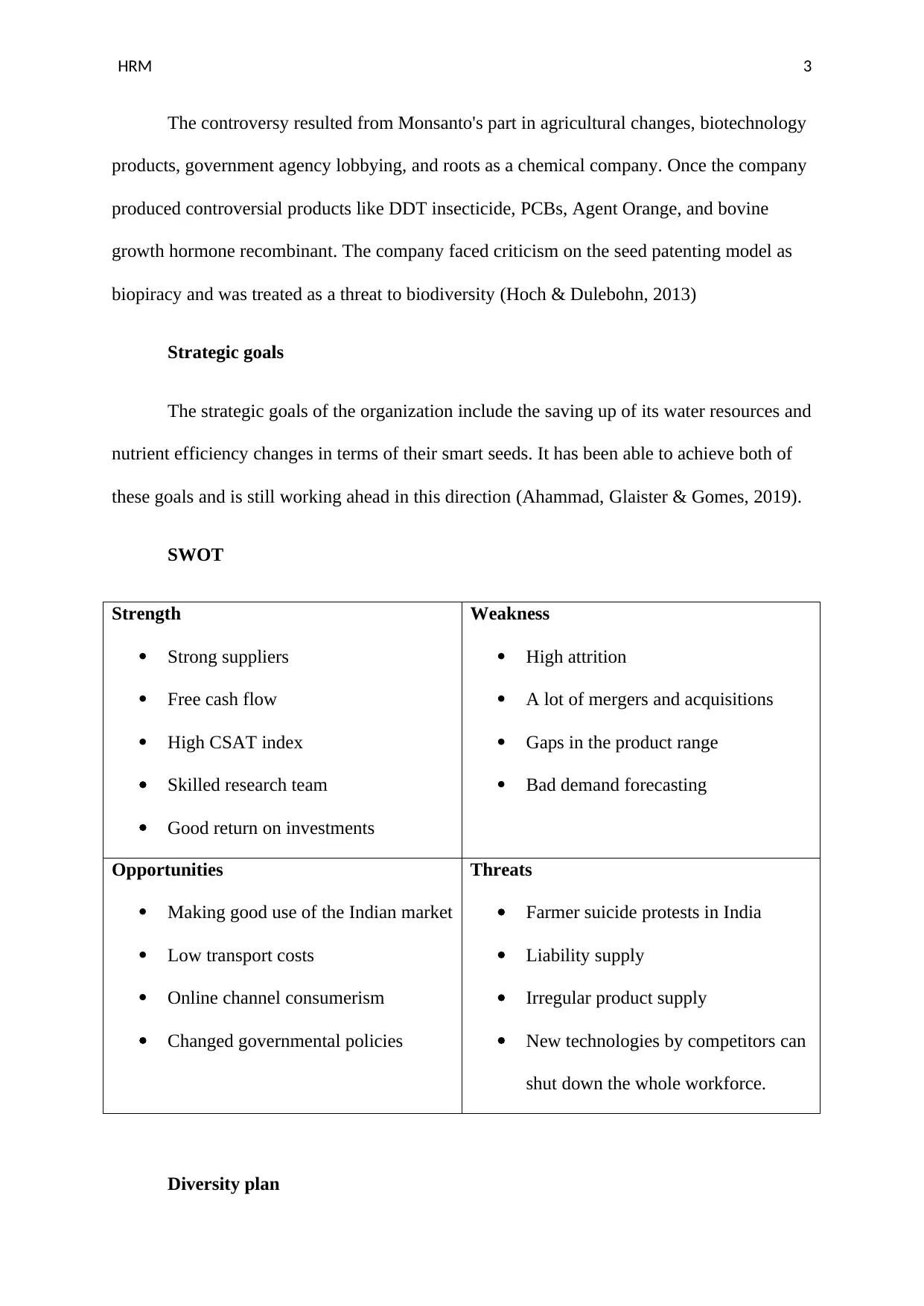
HRM 3
The controversy resulted from Monsanto's part in agricultural changes, biotechnology
products, government agency lobbying, and roots as a chemical company. Once the company
produced controversial products like DDT insecticide, PCBs, Agent Orange, and bovine
growth hormone recombinant. The company faced criticism on the seed patenting model as
biopiracy and was treated as a threat to biodiversity (Hoch & Dulebohn, 2013)
Strategic goals
The strategic goals of the organization include the saving up of its water resources and
nutrient efficiency changes in terms of their smart seeds. It has been able to achieve both of
these goals and is still working ahead in this direction (Ahammad, Glaister & Gomes, 2019).
SWOT
Strength
Strong suppliers
Free cash flow
High CSAT index
Skilled research team
Good return on investments
Weakness
High attrition
A lot of mergers and acquisitions
Gaps in the product range
Bad demand forecasting
Opportunities
Making good use of the Indian market
Low transport costs
Online channel consumerism
Changed governmental policies
Threats
Farmer suicide protests in India
Liability supply
Irregular product supply
New technologies by competitors can
shut down the whole workforce.
Diversity plan
The controversy resulted from Monsanto's part in agricultural changes, biotechnology
products, government agency lobbying, and roots as a chemical company. Once the company
produced controversial products like DDT insecticide, PCBs, Agent Orange, and bovine
growth hormone recombinant. The company faced criticism on the seed patenting model as
biopiracy and was treated as a threat to biodiversity (Hoch & Dulebohn, 2013)
Strategic goals
The strategic goals of the organization include the saving up of its water resources and
nutrient efficiency changes in terms of their smart seeds. It has been able to achieve both of
these goals and is still working ahead in this direction (Ahammad, Glaister & Gomes, 2019).
SWOT
Strength
Strong suppliers
Free cash flow
High CSAT index
Skilled research team
Good return on investments
Weakness
High attrition
A lot of mergers and acquisitions
Gaps in the product range
Bad demand forecasting
Opportunities
Making good use of the Indian market
Low transport costs
Online channel consumerism
Changed governmental policies
Threats
Farmer suicide protests in India
Liability supply
Irregular product supply
New technologies by competitors can
shut down the whole workforce.
Diversity plan
⊘ This is a preview!⊘
Do you want full access?
Subscribe today to unlock all pages.

Trusted by 1+ million students worldwide
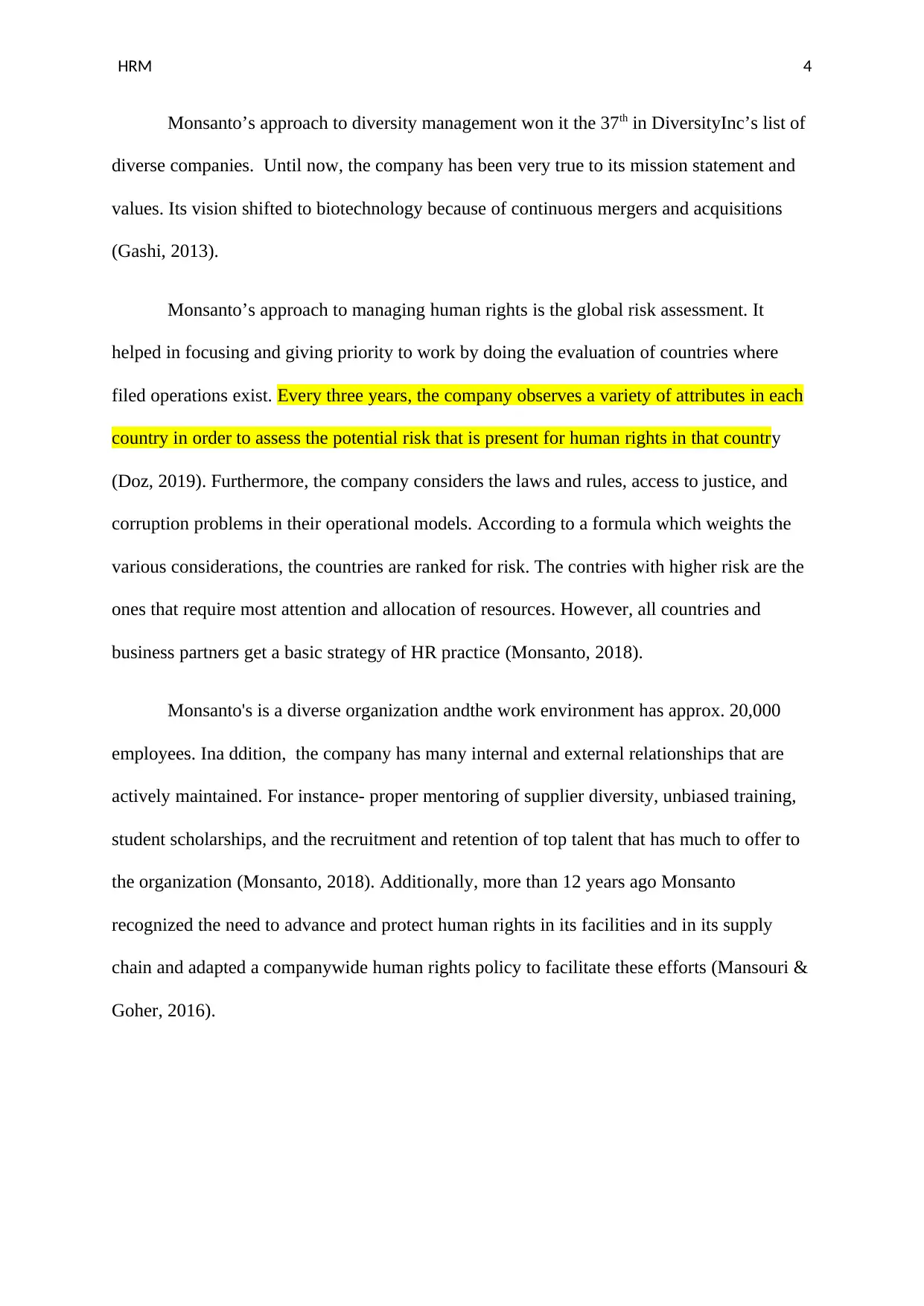
HRM 4
Monsanto’s approach to diversity management won it the 37th in DiversityInc’s list of
diverse companies. Until now, the company has been very true to its mission statement and
values. Its vision shifted to biotechnology because of continuous mergers and acquisitions
(Gashi, 2013).
Monsanto’s approach to managing human rights is the global risk assessment. It
helped in focusing and giving priority to work by doing the evaluation of countries where
filed operations exist. Every three years, the company observes a variety of attributes in each
country in order to assess the potential risk that is present for human rights in that country
(Doz, 2019). Furthermore, the company considers the laws and rules, access to justice, and
corruption problems in their operational models. According to a formula which weights the
various considerations, the countries are ranked for risk. The contries with higher risk are the
ones that require most attention and allocation of resources. However, all countries and
business partners get a basic strategy of HR practice (Monsanto, 2018).
Monsanto's is a diverse organization andthe work environment has approx. 20,000
employees. Ina ddition, the company has many internal and external relationships that are
actively maintained. For instance- proper mentoring of supplier diversity, unbiased training,
student scholarships, and the recruitment and retention of top talent that has much to offer to
the organization (Monsanto, 2018). Additionally, more than 12 years ago Monsanto
recognized the need to advance and protect human rights in its facilities and in its supply
chain and adapted a companywide human rights policy to facilitate these efforts (Mansouri &
Goher, 2016).
Monsanto’s approach to diversity management won it the 37th in DiversityInc’s list of
diverse companies. Until now, the company has been very true to its mission statement and
values. Its vision shifted to biotechnology because of continuous mergers and acquisitions
(Gashi, 2013).
Monsanto’s approach to managing human rights is the global risk assessment. It
helped in focusing and giving priority to work by doing the evaluation of countries where
filed operations exist. Every three years, the company observes a variety of attributes in each
country in order to assess the potential risk that is present for human rights in that country
(Doz, 2019). Furthermore, the company considers the laws and rules, access to justice, and
corruption problems in their operational models. According to a formula which weights the
various considerations, the countries are ranked for risk. The contries with higher risk are the
ones that require most attention and allocation of resources. However, all countries and
business partners get a basic strategy of HR practice (Monsanto, 2018).
Monsanto's is a diverse organization andthe work environment has approx. 20,000
employees. Ina ddition, the company has many internal and external relationships that are
actively maintained. For instance- proper mentoring of supplier diversity, unbiased training,
student scholarships, and the recruitment and retention of top talent that has much to offer to
the organization (Monsanto, 2018). Additionally, more than 12 years ago Monsanto
recognized the need to advance and protect human rights in its facilities and in its supply
chain and adapted a companywide human rights policy to facilitate these efforts (Mansouri &
Goher, 2016).
Paraphrase This Document
Need a fresh take? Get an instant paraphrase of this document with our AI Paraphraser
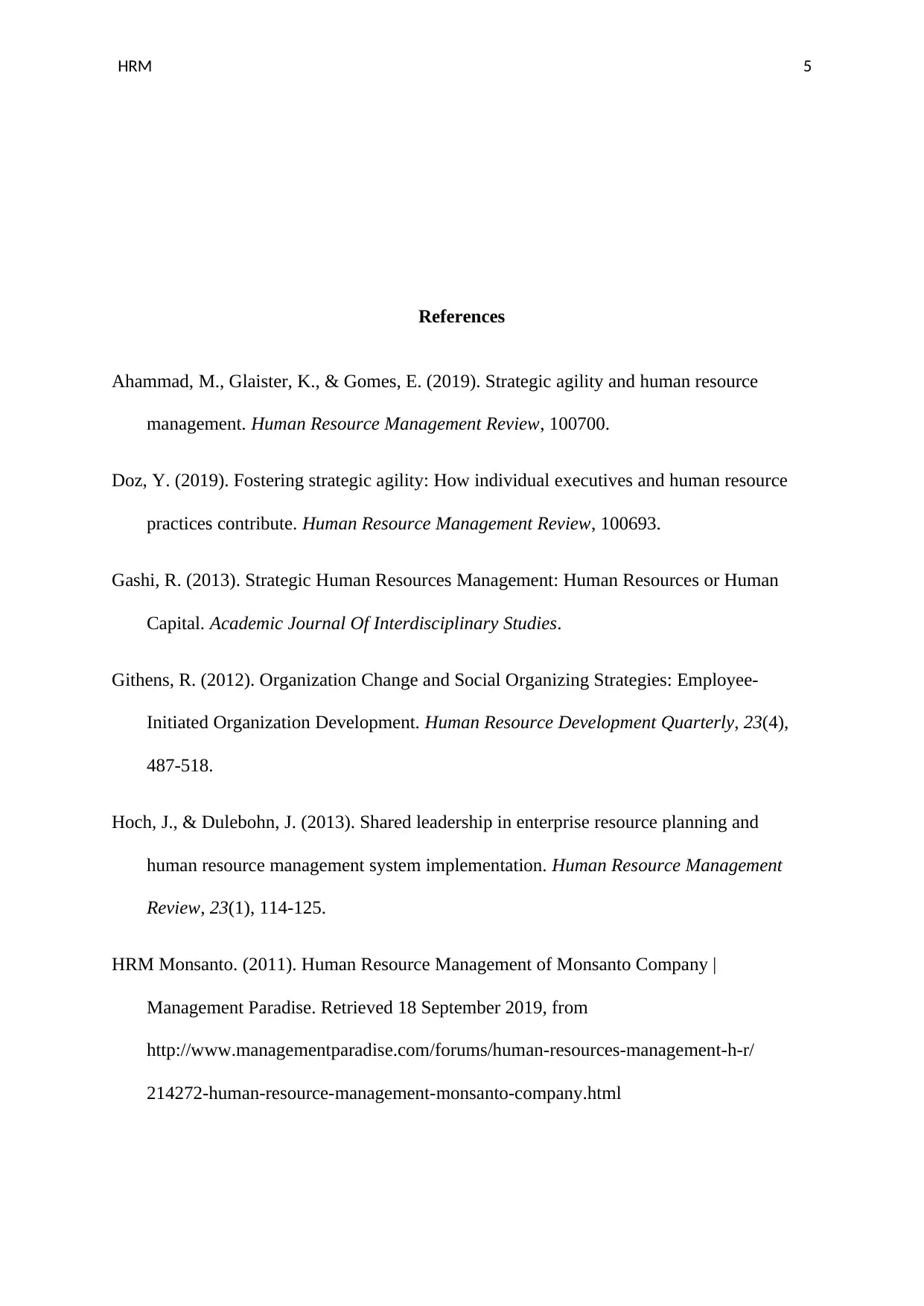
HRM 5
References
Ahammad, M., Glaister, K., & Gomes, E. (2019). Strategic agility and human resource
management. Human Resource Management Review, 100700.
Doz, Y. (2019). Fostering strategic agility: How individual executives and human resource
practices contribute. Human Resource Management Review, 100693.
Gashi, R. (2013). Strategic Human Resources Management: Human Resources or Human
Capital. Academic Journal Of Interdisciplinary Studies.
Githens, R. (2012). Organization Change and Social Organizing Strategies: Employee-
Initiated Organization Development. Human Resource Development Quarterly, 23(4),
487-518.
Hoch, J., & Dulebohn, J. (2013). Shared leadership in enterprise resource planning and
human resource management system implementation. Human Resource Management
Review, 23(1), 114-125.
HRM Monsanto. (2011). Human Resource Management of Monsanto Company |
Management Paradise. Retrieved 18 September 2019, from
http://www.managementparadise.com/forums/human-resources-management-h-r/
214272-human-resource-management-monsanto-company.html
References
Ahammad, M., Glaister, K., & Gomes, E. (2019). Strategic agility and human resource
management. Human Resource Management Review, 100700.
Doz, Y. (2019). Fostering strategic agility: How individual executives and human resource
practices contribute. Human Resource Management Review, 100693.
Gashi, R. (2013). Strategic Human Resources Management: Human Resources or Human
Capital. Academic Journal Of Interdisciplinary Studies.
Githens, R. (2012). Organization Change and Social Organizing Strategies: Employee-
Initiated Organization Development. Human Resource Development Quarterly, 23(4),
487-518.
Hoch, J., & Dulebohn, J. (2013). Shared leadership in enterprise resource planning and
human resource management system implementation. Human Resource Management
Review, 23(1), 114-125.
HRM Monsanto. (2011). Human Resource Management of Monsanto Company |
Management Paradise. Retrieved 18 September 2019, from
http://www.managementparadise.com/forums/human-resources-management-h-r/
214272-human-resource-management-monsanto-company.html
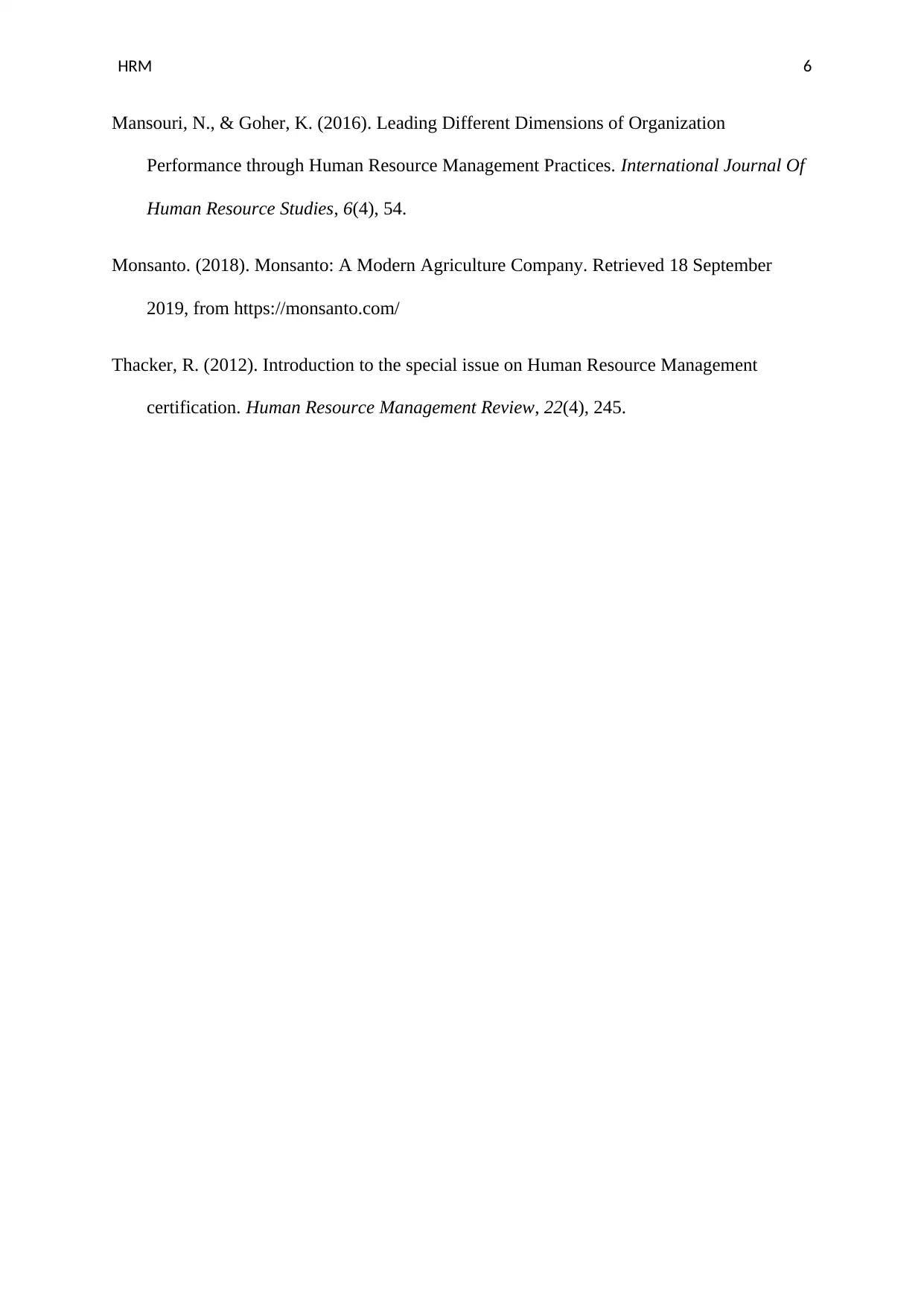
HRM 6
Mansouri, N., & Goher, K. (2016). Leading Different Dimensions of Organization
Performance through Human Resource Management Practices. International Journal Of
Human Resource Studies, 6(4), 54.
Monsanto. (2018). Monsanto: A Modern Agriculture Company. Retrieved 18 September
2019, from https://monsanto.com/
Thacker, R. (2012). Introduction to the special issue on Human Resource Management
certification. Human Resource Management Review, 22(4), 245.
Mansouri, N., & Goher, K. (2016). Leading Different Dimensions of Organization
Performance through Human Resource Management Practices. International Journal Of
Human Resource Studies, 6(4), 54.
Monsanto. (2018). Monsanto: A Modern Agriculture Company. Retrieved 18 September
2019, from https://monsanto.com/
Thacker, R. (2012). Introduction to the special issue on Human Resource Management
certification. Human Resource Management Review, 22(4), 245.
⊘ This is a preview!⊘
Do you want full access?
Subscribe today to unlock all pages.

Trusted by 1+ million students worldwide
1 out of 6
Your All-in-One AI-Powered Toolkit for Academic Success.
+13062052269
info@desklib.com
Available 24*7 on WhatsApp / Email
![[object Object]](/_next/static/media/star-bottom.7253800d.svg)
Unlock your academic potential
Copyright © 2020–2025 A2Z Services. All Rights Reserved. Developed and managed by ZUCOL.
